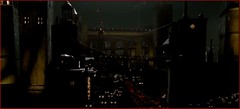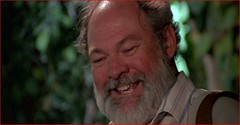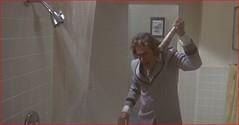
When you think of directors who defined what movies in the 1980s were, it's easy to imagine Spielberg, Hughes or even Landis -- directors who just had a great run of movies that still define that decade. But in my mind, the director who had the most impossible run of movies in the 80s is John Carpenter. It may not have seemed like it at the time, since none of them had much success commercially (save for Escape from New York) or critically (save for Starman), but taken as a whole today, taking into account how well nearly all of them have aged and the enduring popularity they have enjoyed, Carpenter's body of work in the 80s has never received the acclaim it deserves. In this quick rundown of his 80s movies, the general theme I see is tha the took on outlandish projects that probably didn't look too good on paper, or that other directors would have needed a much bigger budget to pull off.
1981: The Fog
After the hugely popular Halloween in 1978, Carpenter of course had to produce another atmospheric thriller, and he wisely took this project in another direction instead of making another stalker/slasher movie. In what would become a common theme in his films, 'The Fog' has a supreme beginning, with a creepy old man telling kids around a camp fire about the secret which has haunted this small Northern California town. Like 'Halloween,' the story is light (ghosts wanting revenge), but the combination of Carpenter's trademark pulsing synthesizer score (always composed by himself) and special effects that hold up well today make 'The Fog' a fine thriller (especially THE shot at the end, which is a great payoff). In the early stage of a decade that was mad for horror/slasher movies, 'The Fog' more closely resembled the Val Lewton horror movies of the 1940s, which had few genuine frights but kept an uneasy feeling throughout the film thanks to a delicately creepy mood and setting.
1981: Escape From New York
With 'Escape,' Carpenter went back to the action/scifi genre that got him his early start in Hollywood with small budget wonders Assault on Precinct 13 and Dark Star, but with this project he would have a budget likely bigger than all of his other films put together. What makes 'Escape' work is an approach Carpenter would make famous throughout his career, with slightly-tongue-in-cheek stories of unapologetic action combined with excellent shot composition and of course his trademark in-house score. This was actually his second collaboration with Kurt Russell, after the 1979 TV movie Elvis, and Carpenter would use the shaggy-haired actor like no one before him. Since he was a child, Russell was cast in Disney movies as a loveable oaf or aw-shucks bumbler, but Carpenter awakened the John Wayne persona inside Russell (which he would use in roles much more frequently from now on) to become the kind of anti-hero 80s audiences so loved. Russell is death row con Snake Plissken, given 24 hours to infiltrate the prison that is New York to save the president after his plane crashed -- or die from the virus recently injected into him from the government. It's a ridiculously Carpenter plot embraced to great effect by the director. 'Escape' was made ageless by Russell's character, as well as the performances by an aging Lee Van Cleef and even Isaac Hayes.
Note: I had a strange encounter in college with a classmate with the last name of 'Plissken': I jokingly asked him if he ever went by the name 'Snake,' and he replied that his actually father went to college with Carpenter and somehow developed the nickname of 'Snake,' which Carpenter of course used to name the character.
1982: The Thing
Carpenter's manic run in the early 80s continued with this remake of the influential 1951 scifi thriller The Thing From Another World. The original film featured scientists thinking their way through a seemingly-invincible foreign foe. Like the original, Carpenter's version would have a remote setting (in this case: Antarctica) and the scientists would stumble upon a UFO of sorts under the ice, but from then on Carpenter's version would go in its own direction: instead of simply being a big brute, the villain would be a shapeshifter, leading to a continuing fight to find out which one of the scientists is really the alien. Again, Russell would be doing his best modern John Wayne impersonation, but he would be upstaged by the special effects, which are shockingly realistic even by today's standards. The outlandish one-liners that were always prevalent in Carpenter's movies are on display devlishly here, capped by Russell's great one at the end: 'Yeah, fuck you too!'
1983: Christine
Another interesting fact about Carpenter is that he made a lot of monster movies ('Halloween,' 'The Fog,' 'The Thing,' 'Prince of Darkness') and that his villains in those movies never had any lines of dialogue. 'Christine' is a perfect example of this, with a possessed '58 Plymouth Fury as the villain. Probably not the best follow-up to the masterpiece that was 'The Thing' (undoubtedly his best movie outside of 'Halloween'), 'Christine' was another example of how Carpenter could push the special effects envelope with a modest budget. After Christine is smashed up, we get a great scene of the car fixing itself, acting as some kind of motorcity T1000, and the effects are flawless.
1984: Starman
One of Carpenter's best-known and most popular movies, 'Starman' went outside his realm of fantasy/action/horror to offer a touching scifi romance with religious overtones. Jeff Bridges was nominated for an oscar for the title role, and Karen Allen was perhaps never better in what was realistically her last quality role of her career. 'Starman' would mark Carpenter's last movie that had truly widespread appeal, outside of the niche audiences that craved his brand of mysticism and horror.
1986: Big Trouble in Little China
For me, this is the 80s. A completely satisfying movie that would never have gotten made in any previous or future decade. I loved this flick so much as a child that I even went so far as to use my family's lone home movie as to record it off HBO (thankfully I only got through the opening credits before I came to my senses). I think of this as Carpenter's Indiana Jones movie, and if Russell was in the John Wayne role in previous Carpenter movies, he IS Wayne in BTLC, going so far as to adopting a mock-Wayne accent throughout the movie. In the DVD commentary, Carpenter remarks that it was originally designed to be a Western, which I think would have been amazing to see, although the costs would have been much higher. As it is, BTLC is the kind of buddy/action/kungfu/Chinese magic movie that rarely comes along. The entrance of the Three Storms has to rank among the best ever, simply because it is completely unexpected and is done with almost no dialogue (save for a few grunts and screams). When people see BTLC for the first time these days, it's easy to mistake it for satire, yet the reason it succeeds as much as it does is because the film is played straight and never once blinks. When Egg and David LoPan are facing off in a black magic video game while a small scale war plays out behind them -- you believe it!
1987: Prince of Darkness
This is probably Carpenter's most forgotten movie of the 80s, but it's one of my new favorites after seeing it recently. Basically Carpenter takes the premise his 'Assault on Precinct 13' and adds some Catholic mythology and makes Satan himself the main villain in what ends up being quite an effective little thriller. When a priest dies, he leaves a key to a door in a condemned ghetto church that unlocks the mystery of the ancient Brotherhood of Sleep, a secret society dedicated to the fact that Satan was captured sometime around the time of the crucifiction. The Ultimate Evil is housed in a cylinder and represented as a swirling green mass, which is itching to get out. For one night, a professor (Victor Wong!), a priest (Donald Pleasance, again playing a character named Loomis) and some college students set out to decipher just what is inside the cylinder and how it got there. All through this, some freaky homeless people (lead by Alice Cooper) are drawn to the church to defend the cylinder and all those inside keep having the same dream, which appears to be a video transmission from the future. It all plays out in true Carpenter fashion, with a typically moody Carpenter score. It's a great concept that gets very tense at the end. Also, if you get the DVD, be sure to watch the trailer -- which seems to go out of its way to spoil the ending like no other trailer I've seen.
1988: They Live!
Carpenter closed the decade with a concept that would later be repeated with The Matrix, but one that ultimately found a small audience at the time. This would mark the end of Carpenter's freedom from studios, which allowed him to essentially choose his own scifi/horror projects. This is not to say 'They Live!' isn't good -- it's lots of fun, and has aged well -- but it's also perhaps too silly for its own good (due in no large part to the casting of Roddy 'Rowdy' Piper in the lead role). When the drifter Nada (Piper) finds a pair of sunglasses in a garbage can, he is able to see the world as it really is: a portion of the population are really aliens that are controlling the masses. Piper and a group of other misfits set out to bring down the system, and along the way he has an infamous fist fight in an alley which was given great tribute by South Park a few years ago (it is choreographed punch for punch from 'They Live!').
Closing: Carpenter was able to put his own personal stamp on all his films, literally -- his title cards almost always bore his name, usually with the same font (see here and here). The projects he chose were not for the paycheck, but because they would further his own unique talents with special effects and scifi/fantasy storytelling. You could argue that after the success of 'The Thing' and 'Starman' he could have become a more mainstream director, but as it is after 'They Live!' he was given one more legitimate mainstream movie, the forgettable Memoirs of an Invisible Man. Its subsequent box office failure sent him down a road of movies that, while probably closer to Carpenter's style (the ill-fated run of Escape from L.A., Vampires and Village of the Damned), they never caught on in the way his earlier movies did. But for a magical eight year run in the 80s, Carpenter found himself in the right time for his particular brand of cinema, and the films he produced in those years are still popular with those who are just now discovering them.
Friday, September 01, 2006
John Carpenter's Decade
Filed Under Essays
Subscribe to:
Post Comments (Atom)












2 comments:
We had a Plissken classmate?
Great post Adam.
You've done Carpenter justice by showing all he accomplished in only 10 years. It is an incredible run of films and not a stinker among them.
It's amazing to think that The Fog and Escape From New York were released in the same year. And then topped himself with The Thing the next year.
It's also hard to look at this decade and then wonder what the hell happened to him. And to see him sit back and take the checks for remake after remake is disheartening. But to look at that decade, you can't argue that he's earned that right.
My film professor was a huge Carpenter fan and I was able to see Assault On Precinct 13 on the big screen and it was amazing. Carpenter had actually written the intro for a book my professor wrote.
Post a Comment